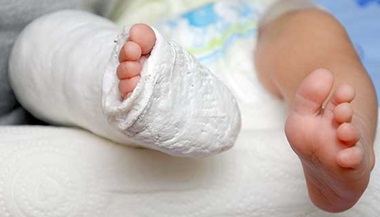Patient Story
Radial Longitudinal Deficiency: Andrew's Story
Patient Story Highlights
- Andrew was born with radial longitudinal deficiency. It shows up as either an underdeveloped thumb or an absent thumb or sometimes a shortened or partially developed radius, which is the bone on the thumb-side of the forearm.
- “The thumb is crucial for the development of a functional grasp pattern,” explains Lee Phillips, M.D., Andrew’s pediatric orthopaedic and hand surgeon at Johns Hopkins All Children’s Hospital.
- Phillips discussed treatment options in-depth with Andrew’s parents, and they decided on a pollicization, a surgical technique in which Phillips removed the thumb and replaced it with a relocated index figure, which would act as a thumb.

Like Nemo’s “lucky fin,” 3½-year-old Andrew has a special left hand. In fact, he’s just starting to notice when he counts his fingers that one of them isn’t there. But he’s cool with it. So are his parents. “Just keep swimming,” as they say in Finding Nemo.
What Andrew really prefers is gymnastics, which he’s just starting and really enjoying so far. “We forgot to even tell his coach about his hand,” laughs mom, Megan. “And she didn’t notice until we mentioned it a few months later. Andrew is participating in all of the same activities as his friends. He’s functioning very well.”
Andrew was born with radial longitudinal deficiency. It shows up as either an underdeveloped thumb or an absent thumb or sometimes a shortened or partially developed radius, which is the bone on the thumb-side of the forearm. Radial longitudinal deficiency occurs in one in 100,000 births.
“The thumb is crucial for the development of a functional grasp pattern,” explains Lee Phillips, M.D., Andrew’s pediatric orthopaedic and hand surgeon at Johns Hopkins All Children’s Hospital, “which includes opposition—or touching—of the thumb to the tip of the index and middle fingers.”
Grasp patterns are important for picking up objects, use of developmentally appropriate tools including spoons, forks, crayons, scissors and pencils and participation in play activities such as building with blocks, throwing a baseball and coloring.
Phillips discussed treatment options in-depth with Andrew’s parents, and they decided on a pollicization, a surgical technique in which Phillips removed the thumb and replaced it with a relocated index figure, which would act as a thumb. Phillips is one of only a few surgeons in the area who performs this particular tricky surgery. Andrew had a cast on his arm for several weeks and followed up with therapy on the hand.
“You remove the metacarpal—the long bone of the hand—shorten the index finger and reposition it where the thumb was,” Phillips says. “The muscles are reconstructed to give Andrew a fully functioning thumb created from the index finger. At 18 months, Andrew’s age was ideal for the surgery. Younger kids are more likely to adapt to the new thumb. He did great.”
Andrew followed up with occupational therapy, which was “very useful in the early stages following his surgery,” Megan recalls. “Especially in educating us in what we can do on a daily basis to optimize his capabilities and what to expect. His therapist was very good at working with him and made the therapy fun.”
Phillips is pleased that a success like Andrew’s can help get the word out. “I just want families to be a little less afraid of this incredible option that can give a child with a non-functional thumb a fully functioning hand,” he says. “The thought of removing a digit can be very scary, but once they see the end result, a missing finger is barely noticeable. Plus they have a child who can now do everything from playing sports to picking up a pen or a fork.”
Andrew has one more surgery scheduled for early 2019 on his other hand. During Andrew’s initial visit, Phillips noticed several joints that were underdeveloped in his right hand and recognized that improvements in functionality could be made with a minor surgery once he had grown a little and his bones were larger.
“We do anticipate some additional occupational therapy after the second surgery and possibly for the original hand as Andrew grows,” Megan adds. “But Dr. Phillips is very pleased with the results of the initial surgery.”
So far, Andrew’s classmates haven’t noticed the hand, but Phillips has prepared the family for potential bullying. “It was a pleasant surprise that Dr. Phillips asked about it, and it reassured us that he will be there for support in helping us deal with it if and when it occurs,” Megan says. Phillips explains that talking the child through the differences in his hand and the benefits that brings him can help prepare him to answer questions when the time comes.
The family is very pleased.
“It makes such a difference to go to a facility designed for children where the staff is so wonderful. The hospital has been fantastic,” Megan says. “Dr. Phillips is very personable with Andrew, and very realistic with his knowledge of Andrew’s development and capabilities.”
Soon he will have two fully functional hands, making gymnastics even more fun.
Call 727-898-2663 if you would like to learn more about Orthopaedic and Scoliosis Surgery.



